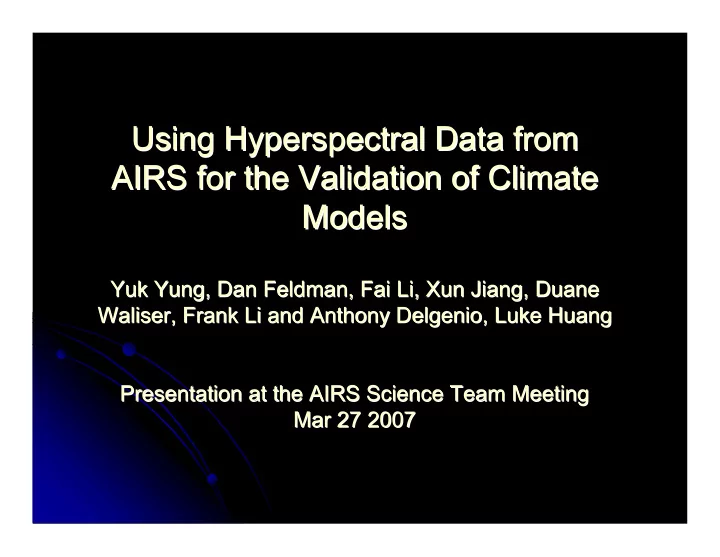

Using Hyperspectral Hyperspectral Data from Data from Using AIRS for the Validation of Climate AIRS for the Validation of Climate Models Models Yuk Yung, Dan Feldman, Fai Fai Li, Li, Xun Jiang Xun Jiang, Duane , Duane Yuk Yung, Dan Feldman, Waliser, Frank Li and Anthony , Frank Li and Anthony Delgenio Delgenio, Luke Huang , Luke Huang Waliser Presentation at the AIRS Science Team Meeting Presentation at the AIRS Science Team Meeting Mar 27 2007 Mar 27 2007
Future climate is like Dark Matter?
Reference Reference Stephens, GL. "Cloud feedbacks in Stephens, GL. "Cloud feedbacks in the climate system: A critical the climate system: A critical review." Journal of climate, Journal of climate, 18 18 (2), (2), review." 2005:237-273. 2005:237-273.
Origins: Origins: Hanel, R. A., Salomons, V., et al ., 1972: Nimbus 4 Infrared Spectroscopy Experiment .1. Calibrated Thermal Emission-Spectra. J. Geophys. Res. , 77, 2629-2641. Haskins, R., R. Goody, and L. Chen, 1999: Radiance covariance and climate models. J. Climate , 12, 1409- 1422. Recent work: Recent work: Huang, X., and Y. L. Yung. (2005). “Spatial and spectral variability of the outgoing thermal IR spectra from AIRS: A case study of July 2003.” J. Geophys. Res. : 110 D12102/2004JD005530.
E.V.= E.V.= 93.3% 85.1% E.V.= E.V.= 8.0% 5.2% Reference Reference Haskins, R. "Radiance Haskins, R. "Radiance covariance and climate covariance and climate models." Journal of climate models." Journal of climate 12 (5), 1999:1409-1422. (5), 1999:1409-1422. 12
Principal Component Analysis (PCA) Principal Component Analysis (PCA) Data Matrix X N time steps M stations ( ) � � 1 T T Covariance Matrix C X X E E M M entries ( ) = = � � N 1 � EOFs e eigenvectors of C : Modes of Spatial Pattern ( ) > = k PCs p X e : Time-dependent Amplitudes of EOFs ( ) > = � k k Eigenvalue: the fraction of variance captured by each EOF > The original data can be represented by > T X p t e � � ( ) ( , ) = � k k k Spectral PCA: Replace time t by frequency ν
Central Pacific (140W, 0N)
Central Pacific AIRS Raw Data GISS Cloudy Sky Brightness Temperature (K) ν (cm -1 ) ν (cm -1 )
Central Pacific AIRS Cloud-Clear GISS Clear Sky Brightness Temperature (K) ν (cm -1 ) ν (cm -1 )
Pacific Cross Section (155W, 20N)
Pacific Cross Section AIRS Raw Spectra GISS Cloudy Sky Brightness Temperature (K) ν (cm -1 ) ν (cm -1 )
Pacific Cross Section AIRS Cloud-Clear GISS Clear Sky
Arrival of Golden Age Arrival of Golden Age (1) Extensive Database. There now exist three extensive datasets There now exist three extensive datasets (1) Extensive Database. taken in 1970-71, 1996-1997, and since 2003, by the Infrared Infrared taken in 1970-71, 1996-1997, and since 2003, by the Interferometer Spectrometer (IRIS), the Interferometric Interferometric Monitor for Monitor for Interferometer Spectrometer (IRIS), the Greenhouse gases (IMG), and the Atmospheric Infrared Sounder Greenhouse gases (IMG), and the Atmospheric Infrared Sounder (AIRS) missions, respectively. In traditional meteorological studies, In traditional meteorological studies, (AIRS) missions, respectively. only a few channels in the thermal infrared are used to constrain the only a few channels in the thermal infrared are used to constrain the energy budget of the atmosphere. The spectral radiances contain energy budget of the atmosphere. The spectral radiances contain thousands, and even tens of thousands of channels. thousands, and even tens of thousands of channels. (2) Quality of Satellite Data. The quality of the AIRS data is The quality of the AIRS data is (2) Quality of Satellite Data. unprecedented. The precision of the data is 0.1 K in brightness unprecedented. The precision of the data is 0.1 K in brightness temperature, based on an absolute on-board calibrator, making the temperature, based on an absolute on-board calibrator, making the data ideally suited for climate variability studies. The spectral data ideally suited for climate variability studies. The spectral resolution is 1 cm-1, allowing individual rotational lines of water resolution is 1 cm-1, allowing individual rotational lines of water vapor to be resolved. The spatial resolution is about 10 km, so that vapor to be resolved. The spatial resolution is about 10 km, so that cloudy and neighboring clear atmospheres can be separated, cloudy and neighboring clear atmospheres can be separated, thereby isolating the effect of clouds from water vapor. thereby isolating the effect of clouds from water vapor.
Arrival of Golden Age Arrival of Golden Age (3) Quantity of Satellite Data. of Satellite Data. The quantity of data is staggering. To The quantity of data is staggering. To (3) Quantity date, AIRS has collected 10 billion (1010) spectra of the Earth’ ’s s date, AIRS has collected 10 billion (1010) spectra of the Earth outgoing spectral radiances. These data, together with their high outgoing spectral radiances. These data, together with their high quality, will be used to produce the best climate statistics, especially quality, will be used to produce the best climate statistics, especially second order moments, for comparison with climate models. second order moments, for comparison with climate models. (4) Comparison between Observations and Models. Second- Second- (4) Comparison between Observations and Models. moment statistics are related to the sensitivity of the climate system moment statistics are related to the sensitivity of the climate system to an external forcing. At present, two climate models from the to an external forcing. At present, two climate models from the National Center for Atmospheric Research (NCAR) and the National Center for Atmospheric Research (NCAR) and the Goddard Institute for Space Studies (GISS) are being run at JPL for Goddard Institute for Space Studies (GISS) are being run at JPL for comparison with spectral radiances. We are provided data from comparison with spectral radiances. We are provided data from GSFC/GEOS-5 (NASA GSFC/GEOS-5 (NASA’ ’s newest GCM) and GFDL. s newest GCM) and GFDL.
Recommend
More recommend